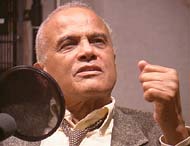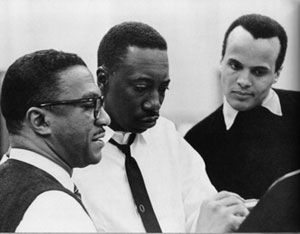
So Madonna has given Warner Brothers the boot in favor of concert promoter Live Nation, while at the same time Radiohead has devised a pay-what-you’d-like scheme for their latest self-produced, self-distributed release, thumbing their noses at long-time label EMI. All in the space of a few days. The blogosphere – and the mainstream media, for that matter, are all a-twitter.
Have we reached, then, the Tipping Point? Is it curtains for certain for the much-lambasted Record Industry?
Frankly, I think the tipping has already happened. And I’m also not persuaded that the record industry’s days are over …. so long as they don’t think of themselves solely as purveyors of recorded, um “product” as Billboard magazine terms it.
One of the things I’ve discovered in plying the classical, jazz, folk, etc. waters over the years is that these minority formats tend to be the canaries-in-the-coal-mine for the bigger genres. Long before it was a gleam in Thom Yorke or Trent Reznor‘s eye, the excellent classically-oriented Magnatune label was offering the pay-what-you-think-its-worth option. And for some serious artists with serious credentials, too, many of whom had recorded for the so-called “major” labels. The Economist introduced me (and, it turns out, a whole of folks) to the Magnatune concept more than two years ago:
From a listener’s point of view, the firm’s website is enticing. You can legally listen, free of charge and with high sound quality, to full albums by any of the 200 or so artists who have signed to the label. (Your correspondent was immediately hooked by a song called Making Me Nervous by a one-man electro-pop band from Ottawa called Brad Sucks.) Music streamed is free, but to download it to your computer or burn CDs, you have to pay. Just how much is a matter of choice—Magnatune allows you to decide what the music is worth, and to pay as little as $5 for an album or as much as $18. Once paid for, the music is not locked up using digital-rights management software, so you are not prevented from making copies.…
Magnatune was born out of the simple reality that is known to any classical musician: You don’t make your money from record sales. There are possibly a half-dozen living classical musicians you have a positive income stream from their recordings: Yo-Yo Ma, James Galway, Renee Fleming, Placido Domingo, Van Cliburn, and… Andrea Bocelli? Go ahead, name another.
Same is true in jazz. I’ll bet the only artists that actually get any meaningful income from records are Dave Brubeck (thanks to the perennial popularity of Time Out, released in 1959) and maybe Diana Krall.
And even in larger the pop-music sea, that’s not and never has been where the money is — for 90% of the artists, that is. Even in the best of times working with a label was a deal-with-the-devil cost-of-doing-business proposition: You signed with a major because of the potential they represented to promote, market, and, if you got lucky, actually to move mass quantities of your physical “product” into the hands of your fans. Can’t do that selling your self-produced record out of the back of your trunk and running handbills off on a mimeo machine in the back room.
Hmmm…but in the iTunes world you suddenly don’t have to worry about having the supply to meet the demand, do you? Thus a big-name well-established act like Radiohead, with a carefully-cultivated image-conscious fan base, doesn’t really have much more use for EMI. No wonder the label’s new prez Terry Hands said it was a “wake up call,” according to a leaked internal e-mail:
The recorded music industry… has for too long been dependent on how many CDs can be sold,” Hands wrote. “Rather than embracing digitalization and the opportunities it brings for promotion of product and distribution through multiple channels, the industry has stuck its head in the sand.”
Hands warned that more artists could follow Radiohead’s lead and take their careers into their own hands. “Why should [superstar acts] subsidize their label’s new talent roster – or for that matter their record company’s excessive expenditures and advances?” asked Hands.
Why indeed? And that’s where the Madonna / Live Nation model is so interesting — it’s part of a larger chess match within the music industry:
Madonna’s deal to abandon Warner Music for concert promoter Live Nation signals more than just a tectonic shift in the music distribution business: It shows how far Live Nation is willing to go to break the hammerlock Barry Diller‘s Ticketmaster has on online concert ticket sales.
The core benefit to Live Nation of the $120 million recording and touring contract with the pop superstar is the opportunity to tap into concert, recording, merchandising and other lucrative revenue streams. But don’t discount the role that lowly ticket fees play.
Ticket buyers may be annoyed by the $5 or more in fees tacked on to every ticket ordered online or over the phone, but they’ve proven to be a gold mine for Ticketmaster. Ticketmaster’s revenues jumped 14 percent to $1.1 billion in 2006 and generated almost a 25 percent operating profit margin.
Thus, To these eyes the “three-CD deal” (with up to $50 million in “advance payments”) is really a “signing bonus” for Madonna, in order to cash in on where the REAL money will be made. I think Digital Music News editor Paul Resnikoff gets it right:
“…You can’t download a live concert – at least the real, in-the-flesh experience. Maybe you can hop onto BitTorrent and grab some amazing concert footage. Or even purchase a live performance album release. But what is your girlfriend (or boyfriend, bff, sibling, spouse, child, etc.) going to get more excited about – a video download, or a real ticket to a real show?One can be duplicated, viewed on-demand, and buried within a massive iTunes library. The other is a one-time, once-in-a-lifetime opportunity. Labels are now specialized in producing assets that can be reproduced instantly and infinitely. They are also specialized in an asset that is increasingly generating excitement for other assets they do not control.
Live Nation makes its money off of something that can never be duplicated. And that is why they can afford the elephantine deal terms to lure Madonna.
And even, if they don’t get all of the $120 million back out of Madonna (who will be 60 when the deal ends!), what’s the value to Live Nation if they can break Ticketmaster’s hammerlock on sales??? I’d say……Priceless.
So after reading all this, there IS a next logical step for the much-maligned record companies….what if Ticketmaster, for example, went out and bought EMI, a well-oiled production, distribution, and marketing machine?















You must be logged in to post a comment.